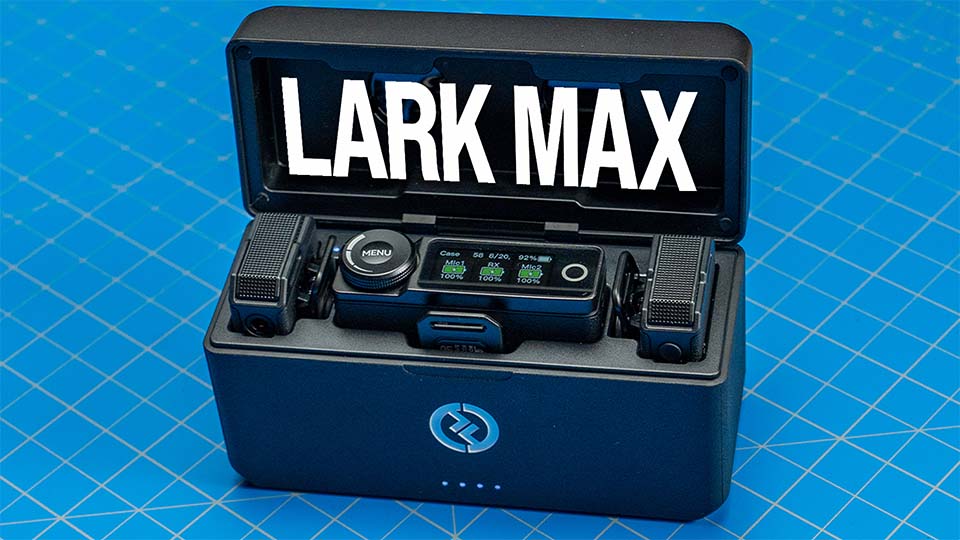Links in this post may be affiliate links. Any products purchased through affiliate links may provide a small commission which helps to support the SemiPro Tech+Gear site and YouTube channel.
The Hollyland Lark Max is a wireless microphone kit that directly competes with Rode’s Wireless GO II and DJI’s mic kit at the $300 price point. It seems that Hollyland took aim at many of the issues with those microphone systems and attempted to solve them with the Lark Max. Did they succeed?
I could end my analysis here by simply saying: yes, they succeeded. But of course, there’s more to the story than that. The Lark Max does indeed provide much more for the price compared to the Wireless GO II, more in line with what the DJI mic kit offers. However the Lark Max also succeeds in providing (in my opinion) better audio results.
Hollyland Lark Max
MSRP: $299.99
Pros
- User experience is intuitive – receiver menu is great
- Excellent sound quality (more full than competitors)
- USB compatible with iOS & Android
- 24-bit WAV internal recording for 14 hours
- Great value for the price
Cons
- Transmitters don’t work with locking-connector lav mics
- Low cut mode is a bit aggressive (150Hz HPF)
- Safety track is -6dB (-12 or -20 would be safer)
Best For: Any content creator needing a wireless mic solution, unless the new Rode Wireless Pro is within your budget.
Code SEMIPROTECHGEAR at Hollyland will provide 8% off
Features & Connectivity
Hardware features of the Lark Max include:
Receiver:
- USB-C & 3.5mm output (can be used simultaneously)
- 3.5mm headphone output (not latency-free due to wireless)
- Transmitter gain control
- 8hr battery life
- 24-bit / 48kHz output over USB
- Recording Modes: Mono, Stereo, Safety
Transmitters:
- Built-in microphone
- 3.5mm TRS input for external mics
- Freq response (built in mic): 20Hz – 20kHz
- Max SPL: 128dB
- 2.4GHz wireless transmission
- Noise reduction on/off control
- 7.5hr battery life
Kit:
- Charging case with USB-C port (2800mAh)
- 2x deadcats for transmitter
- 3.5mm TRS cable
- USB-C to USB-C cable
- USB-C to USB-A cable
- USB-C to lightning cable
The transmitters and receiver automatically charge when placed in the case and status lights outside the case indicate how much charge is left in the case. The transmitters automatically connect to the receiver when you remove them from the case.
Both the USB and 3.5mm output of the receiver can be used simultaneously to send audio to a computer or mobile device and into your camera. The transmitters also offer internal recording at the press of a button, with 8GB of storage providing up to 14 hours of recording at 24-bit, 48kHz.
There are three recording modes and three EQ modes which are set through the receiver menu. Recording modes include stereo, mono, and safety track (-6dB right channel), and EQ modes include HI-FI, Low Cut, and Vocal Boost.
Sound Quality & User Experience
The sound quality of the built-in microphone of the Lark Max is excellent for a wireless kit in this price range. The Vocal Boost EQ mode provides a rich sound, with more low end than the competition. The Rode Wireless GO II sounds almost thin by comparison. There is a bit more depth to audio recorded internally and over the USB output compared to the camera output, but that’s not unique to the Lark Max. When relying on the relatively low quality preamps and converters in your camera (even in $2-4k mirrorless cameras), the audio comes out sounding a bit thinner with less dynamic range in-camera.
The user experience of this kit is excellent. Open the case and it just works – the automatic connection and charging, and the simple and straightforward menu system on the receiver all make the kit very easy to use. I did not encounter anything while using the Lark Max that required me to stop my filming process to figure something out.
The EQ modes are all useful, though the low cut mode is a tad aggressive for regular use. The low cut filter is set at 150Hz, which successfully rolls off low frequency rumble like airplanes and trains nearby, however if you have a lower-pitched voice that will also result in the dialog sounding thin and less natural. So I would recommend using a more precise high pass filter in post if possible. The recording modes are also all useful, however the safety track mode is not the “safest” I’ve seen. In safety track made, the right channel is set -6dB lower to avoid clipping. However if gain is set excessively high, -6 might not be enough of a reduction. I would like to see the safety track set at -12 or even -20 dB to truly ensure clipping won’t occur.
The only thing I ran into that will be a big deal for some but not everyone is that the 3.5mm input on the transmitters is not compatible with lavalier microphones that have locking connectors. I tried two and neither one could be inserted far enough to be recognized by the the transmitter. This is too bad, because even though the Wireless GO II doesn’t have threads for locking connectors, you can plug them in far enough to work.
Other than those minor (depending on whether you own locking-connector lav mics) shortcomings, I found the Lark Max a joy to use.
Final Thoughts
So who is the Lark Max best for? Well, it’s actually easier for me to articulate who I wouldn’t recommend the Lark Max to, because I personally think it’s one of the best options on the market for wireless mic kits in the $300 price range. I would wholeheartedly recommend it above the Rode Wireless GO II. That being said, here’s a few reasons why you may want to look at other options:
- If you already own several locking-connector lavalier microphones and plan to use them with your wireless kit. They won’t work with the Lark Max transmitters, so this wouldn’t be the best option for you.
- If you are already invested in the Rode ecosystem – specifically, if you’re using Rode Connect for podcasts or streaming and/or you use the Rodecaster Pro 2 or Rodecaster Duo devices. Rode’s wireless mics are compatible with Rode Connect over USB and can transmit wireless audio into the newer Rodecaster devices (not the original). If you’re already comfortable with those in your workflows, then Rode’s wireless mic kits may be a better fit.
- If your budget goes up to $400, then I would consider taking a look at the recently released Rode Wireless Pro. For $100 more, it offers 32-bit float internal recording, timecode functionality, and comes with all the needed accessories including a charging case. This makes the Wireless Pro very attractive if your budget goes beyond the $300 price point.
Ultimately, if you are looking for a quality wireless mic kit at this price range, I don’t think you can do much better than the Lark Max.


